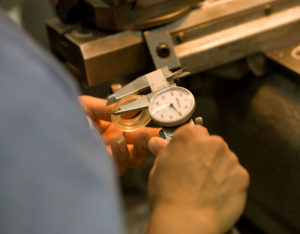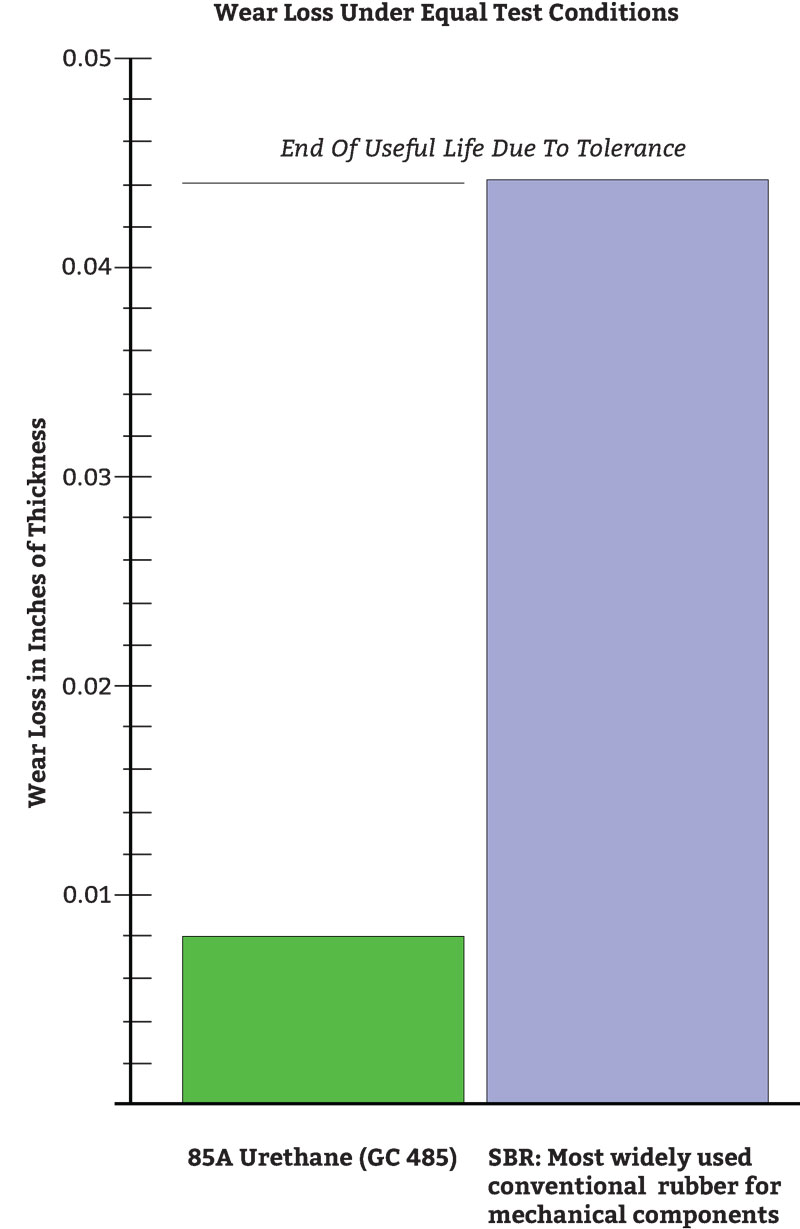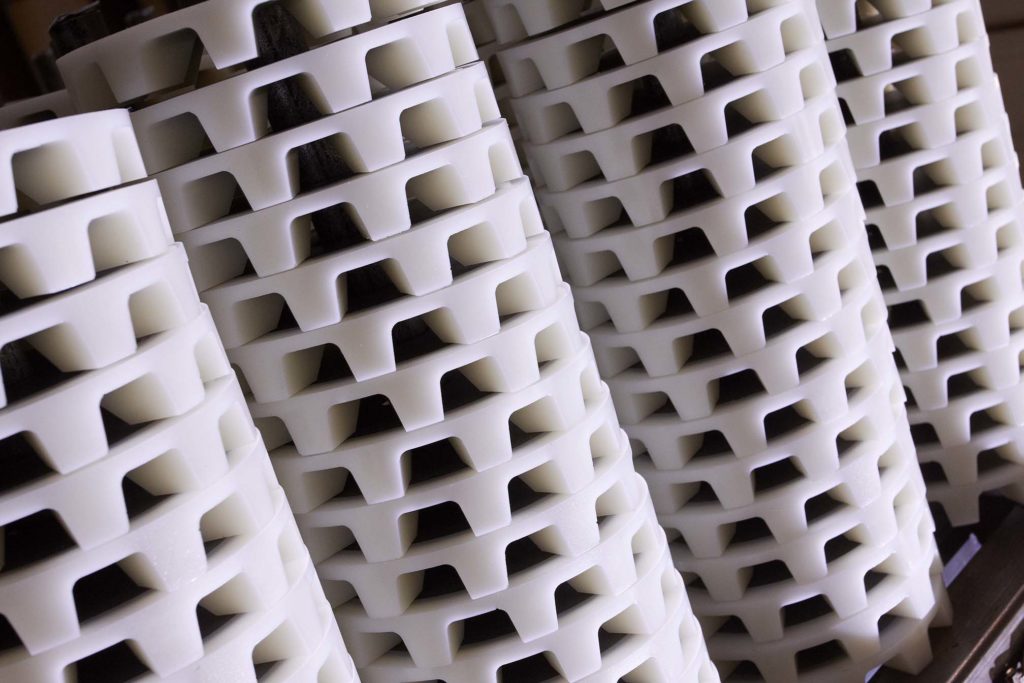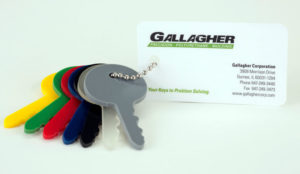Types of Polyurethane
There are 14 types of rubber in general use. All of these polyurethane elastomers have been commercially successful, but they are all different in several ways. The chart below provides a quick initial screening guide of these types of polyurethane elastomers.
Isocyanates
- Toluene Diisocyanate (TDI)
- Diphenylmethane Diisocyanate (MDI)
- Paraphenylene Diisocyanate (PPDI)
- Toluidine Diisocyanate (TODI)
- 1,5-Naphthylene Diisocyanate (NDI)
Polyols
- Polyester
- PPG Polyether
- PTMEG Polyether
- Polycaprolactone
- Polycarbonate
Curatives
-
- 1,4-Butanediol (BD)
- 1,3-Propanediol
- Ethacure 300
- HQEE
- MOCA
While Gallagher Corporation has the technical expertise and equipment to process any of these types of polyurethane, the combinations most typical to Gallagher include:
-
-
- TDI Polyester with hardness ranging from 70A to 70D
- MDI Polyester with hardness ranging from 85A to 95A
- TDI PTMEG Polyether with hardness ranging from 90A to 70D
- MDI PTMEG Polyether with hardness ranging from 60A to 95A
- TDI Polycaprolactone with hardness ranging from 60A to 55D
- NDI Polyester (Vulkollan®) with hardness ranging from 65A to 60D
-
TDI Polyester materials cured with MOCA produce tough elastomers that have outstanding abrasion resistance and excellent oil and aliphatic solvent resistance.
MDI Polyester materials cured with 1,4-Butanediol produce FDA wet and dry food grade urethanes which are tough, abrasion and tear resistant.
TDI PTMEG Polyether materials cured with MOCA have excellent low-temperature flexibility, excellent dynamic properties are resistant to microbial attack and hydrolysis.
MDI PTMEG Polyether materials cured with 1,4-Butanediol have high resilience (even at low temperatures), great dynamic properties, outstanding hydrolysis resistance and improved resistance to impingement type abrasion. Some MDI Ethers can be formulated to be FDA wet and dry food approved.
TDI Polycaprolactone materials cured with MOCA have better hydrolysis resistance than other polyesters while maintaining great resistance to abrasion. These materials also have great tear strength even at low hardness.
NDI Polyester cured with 1,4-Butanediol is trademarked with the name Vulkollan®. Vulkollan® is an ultra-high performance material that has the highest mechanical load bearing ability and is the best choice for highly dynamic applications.
Understanding the physical properties of the various cast types of polyurethane is key to proper design and specification of a successful urethane part.
Consider the physical properties of hardness, fatigue, shear, and abrasion resistance. Need help? Contact Gallagher and we can help you determine what are the best solutions for your unique application.
Polyurethane Load Bearing Ability
Molded polyurethanes have excellent load bearing ability. When placed in compression urethanes can support higher loads than other elastomers of similar hardness. The high load capacity allows molded urethane components to be made smaller resulting in reduced weight and cost of raw materials. The magnitude of compressive force which can be supported by a given polyurethane compound is dependent on three main factors: hardness, loaded surface condition and shape factor.
Physical Properties: Hardness
One of the most common ways to classify polyurethane elastomers is by hardness. Hardness is defined as the relative resistance of a surface to indentation by an indenter of specified dimension under a specified load.
The most common way to measure hardness is with the use of a durometer. Durometers are used to assign a numerical hardness value based on the depth of penetration of the indenter. A harder polyurethane sample will be more resistant to indentation by the indenter and thus will give a higher durometer reading. The hardness range of elastomers is so broad that a single durometer cannot indicate practical measurable differences of hardness. For this reason, durometers are available in more than one scale. The A scale durometer is widely used throughout the rubber industry. The D scale durometer has a stiffer spring and a more pointed indenter; it’s used to measure the hardness of hard polyurethane.
Free Polyurethane Sample Keys
Go to our Contact Form to get a free set of Durometer Hardness Samples.
 The typical hardness range for polyurethane compounds processed at Gallagher is 55A up to 80D; this range can be expanded based on specific applications. The A scale is used for softer compounds; at Gallagher, the A scale is used for compounds from 55A up to 95A. The D scale is used for harder compounds from 50D up to 80D. There is no linear relationship between the A scale and the D scale, however, a 95A is just slightly softer than a 50D. For comparison purposes, a rubber band is about a 35A, the tire tread on your car is about a 70A, the wheels of a roller skate are about 85A and a hard hat is about a 70D.
The typical hardness range for polyurethane compounds processed at Gallagher is 55A up to 80D; this range can be expanded based on specific applications. The A scale is used for softer compounds; at Gallagher, the A scale is used for compounds from 55A up to 95A. The D scale is used for harder compounds from 50D up to 80D. There is no linear relationship between the A scale and the D scale, however, a 95A is just slightly softer than a 50D. For comparison purposes, a rubber band is about a 35A, the tire tread on your car is about a 70A, the wheels of a roller skate are about 85A and a hard hat is about a 70D.
Hardness can be a useful indicator of how a polyurethane part will perform based on loads and deflections. Keep in mind, however, that many different prepolymer-curative combinations can be used to achieve the same hardness.
Physical Properties: Polyurethane Fatigue Considerations
In reviewing physical properties for urethane, fatigue is an important consideration in the design of parts for cyclic dynamic applications. Fatigue and cut growth resulting from cyclic stress-strain are related. When testing for fatigue resistance for a specific application, it’s important to test at a strain energy experienced by the part in actual service.
 Strain energy is a function of both the modulus of the material and the strain cycle the material sees. Also important with polyurethanes is to test at various levels of stoichiometry (polymer to curative ratio) because we have seen dramatic improvements in flex fatigue resistance by this chemical adjustment.
Strain energy is a function of both the modulus of the material and the strain cycle the material sees. Also important with polyurethanes is to test at various levels of stoichiometry (polymer to curative ratio) because we have seen dramatic improvements in flex fatigue resistance by this chemical adjustment.
This is another reason why teamwork between the design engineer, the product engineer, and our chemists is so important to problem-solving.
Physical Properties: Polyurethane Shear
Elastomers in shear are generally used in mounting and suspension applications. Urethane elastomers deflect more easily in shear than in compression. Deflection of a urethane system in shear is a function of three things: the shear stress, the shear modulus – G – of the urethane compound, and the thickness of the urethane.
For bonded urethane applications used in shear, it’s pivotal that certain design guidelines are followed. When under shear loading, the bond line is in tension. By utilizing generous fillets, stress risers are eliminated or greatly reduced at the bonded interface.
In every application that would use the high shear strength of urethanes, the weakness is the dependence on a good bond between the urethane and metal. There are specific ways Gallagher has successfully overcome this weakness. Contact us to learn more.
Physical Properties: Polyurethane Abrasion Resistance
 Unquestionably, the urethanes have outstanding abrasion resistance. They outwear metals, plastics, and other rubbers by a wide margin, often by 8 to 1 or more.
Unquestionably, the urethanes have outstanding abrasion resistance. They outwear metals, plastics, and other rubbers by a wide margin, often by 8 to 1 or more.
Abrasion is caused by many actions, such as impingement, erosion, impact, scuffing, and sliding. Add to that the many variables which affect the abrasion rate such as pressure, temperature, velocity, and lubricity.
It’s obvious, then, that abrasion is very application specific. There are a few standard tests such as the National Bureau of Standards (NBS), DIN and the Taber Abrasion that provide guidance, but specific tests often have to be designed to closely approximate the intended service.
Read our Case Study on Polyurethane Abrasion Testing.
Here are some empirical conclusions we have formed over the years of following field tests:
- Soft, resilient compounds (60A-85A) last longest in particle impingement types of service.
- Medium durometer, resilient compounds of 85A-95A, last longest in abrasive slurry pump impellers, etc.
- 90A-95A durometer compounds work best in impact and sliding types of abrasion found in sand, gravel, coal and ore mining applications.
- The very hard compounds (65D-70D) durometer work best in bushing and bearing applications in wet or dry environments, often where sand, grit or mud are present.
There is no substitute for a field test of 2 or 3 chosen compounds. With our experience and knowing your field performance, we can help you select test candidates. Read our Abrasion Resistance White Paper.
Ask about our Gallagher Quality Guarantee!
- Great products — On time
- Guaranteed to meet your specifications
- Performance will vary based on formulation and application.
- Contact us to find out what guarantee we can provide for your specific, custom product or application.



